Among the thousands of bird species, some stand out as proof of avian diversity thanks to their remarkable plumage! As such, it’s no wonder ornithologists and bird enthusiasts have been interested in these groups of birds. Many focus particularly on black birds with striking characteristics that make for an elegant contrast between feather colors.
Today we’ll focus on some of these birds – more precisely, on black birds with orange beaks. You’ll soon notice that the unmistakable combination between their black plumage and bright beaks gives them an extraordinary appearance.
9 Black Birds with Orange Beaks
Although we focused primarily on fully black birds with orange beaks, some aren’t 100% black. Still, we decided they deserve a spot on our list, as the fascinating contrast between their plumage colors will take your breath away – that is, if you add them to your must-see list and follow your dream of observing them in real life!
1. Gray-winged Blackbird
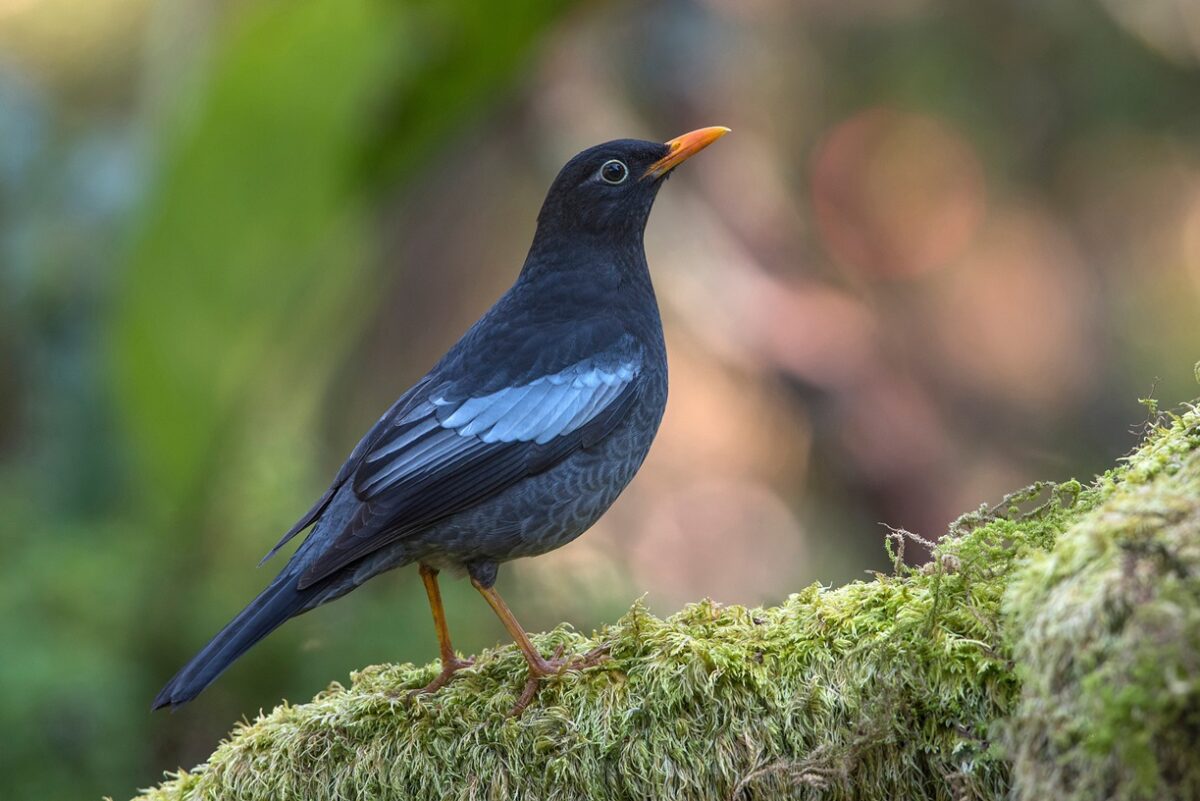
- Scientific name: Turdus boulboul
- Size: 27-29 cm (10.6-11.4 in)
- Weight: 85-105 g (3-3.7 oz)
The gray-winged blackbird is part of the Turdidae family. Like most bird species, it is sexually dimorphic. Males are predominantly black but have gray feathers on their wings. The bill is orange, while the eye ring is yellowish. Females are mostly olive-brown, being slightly lighter on the wings. The bill is orange as well but duller in color.
This species’ range is restricted to southeastern Asia, extending from the Himalayas to Vietnam. They are year-round residents.
Gray-winged blackbirds live in subtropical or tropical forests, usually montane or submontane evergreen forests, although they occasionally visit gardens and parks. During the breeding season, which occurs between March and August, gray-winged blackbirds build nests by using grass, moss, lichens, and ferns, to name a few.
As for their diet, gray-winged blackbirds feed primarily on insects but sometimes feast on earthworms, snails, and fruits.
2. Toco Toucan
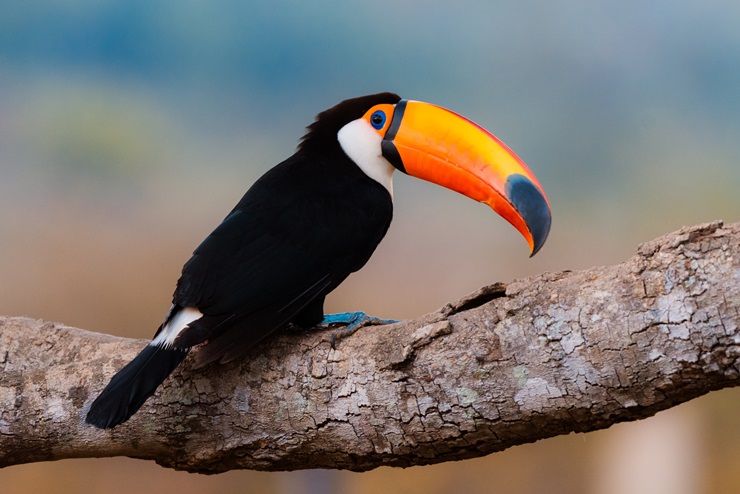
- Scientific name: Ramphostos toco
- Size: 55-65 cm (21.7-25.6 inches)
- Weight: 500-876 g (17.6-30.9 oz)
- Wingspan: 50-119 cm (19.7-46.9 inches)
The toco toucan is often called the common toucan or giant toucan. It is the most renowned member of the Ramphastidae family.
Toco toucans are almost completely black, except for their throats, chests, and uppertail coverts, which are white. Moreover, the undertail covers are red. The bill is by far the most distinguishable characteristic of the species – it is long, broad, and of a yellow-orange color. Males and females are almost identical in appearance, although males are larger than females.
Toco toucans are found in Bolivia, Peru, Argentina, Paraguay, and Brazil. However, other populations are found in other regions of South America as well. Unlike other toucans, toco toucans aren’t forest fans and prefer living in savannas, woodlands, and other open habitats.
Their large beaks are primarily used for foraging and feeding, especially when they eat fruits. However, toco toucans sometimes feed on insects, frogs, and even small reptiles or birds.
Toco toucans do not migrate, and the beginning of the breeding and nesting seasons vary geographically.
3. African Skimmer
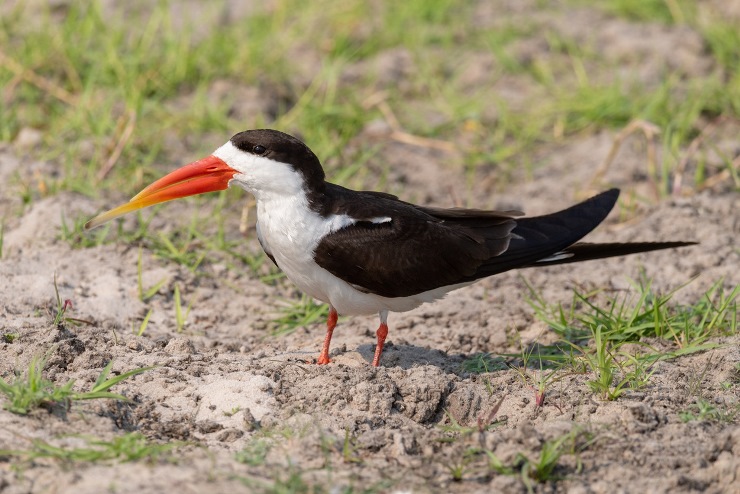
- Scientific name: Rynchops flavirostris
- Size: 38 cm (15 in)
- Weight: 110-200 g (3.9-7 oz)
- Wingspan: 106 cm (41.7 in)
The renowned African skimmer! This is such a beautiful bird that we couldn’t not add it to our list! These birds have contrasting black-and-white plumage, the black feathers being predominant on the back, crown, and hindneck.
The bill is long and bright orange, ending with a yellow tip. But that’s not the only unique thing about the bill! Did you know that the lower mandible is much longer than the upper one?!
African skimmers are common birds in Sub-Saharan Africa, living on lake shores and coastal lagoons. They are partial migrants, and their movements depend on the beginning and ending of the dry season.
During the breeding season, African skimmers build nests on large sandbanks, usually alongside others of their kind, as well as other birds like white-fronted plovers and collared pratincole.
This notable bird has a unique feeding technique as well – it flies over calm water, dipping the lower mandible in water, and when it touches a fish, it closes its mouth to trap it inside.
4. Tufted Puffin
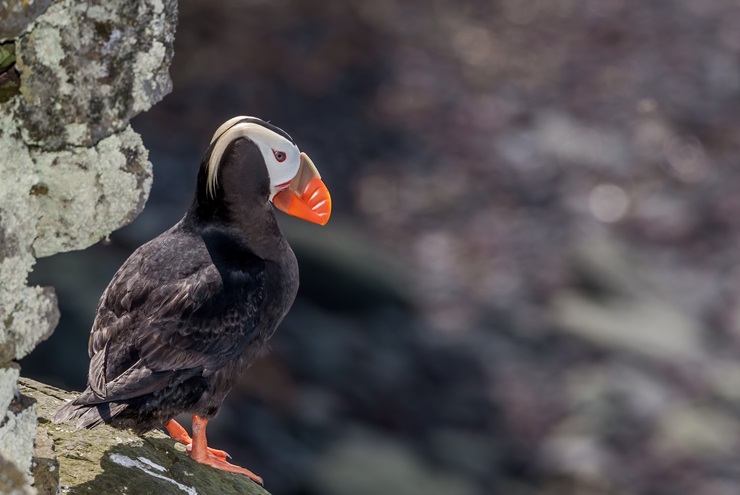
- Scientific name: Fratercula cirrhata
- Size: 35 cm (14 in)
- Weight: 0.7 kg (1.6 lb)
- Wingspan: 63-74 cm (24.8-29.1 in)
The tufted puffin could easily reach the top of the list of the world’s most special birds! They are black, and have a distinctive white facial patch, as well as a short, thick bill of a bright orange-reddish color. Close to the breeding season, both males and females develop yellow tufts, while their feet become bright red.
Tufted puffins are common throughout the North Pacific Ocean, most of them being migratory. During the breeding season, they form breeding colonies on isolated islands and lay their eggs in burrows or crevices between rocks.
Their diet depends on the birds’ age and location. For example, while adults feed primarily on invertebrates, nestlings typically eat fish. Their wings are well-adapted for hunting aquatic prey since they allow tufted puffins to dive and swim underwater.
5. Common Hill Myna
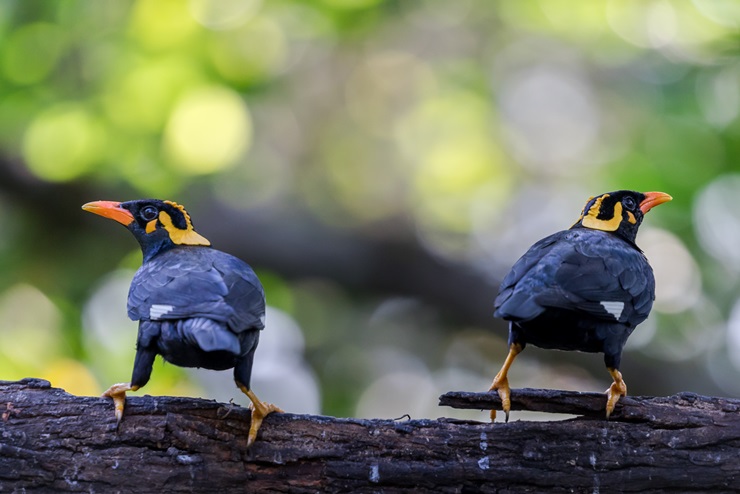
- Scientific name: Gracula religiosa
- Size: 27-31 cm (10.6-12.2 in)
- Weight: 161-229 g (5.7-8 oz)
- Wingspan: 26-45 cm (10.2-17.7 in)
The common hill myna is yet another beautiful black bird, but there’s so much more to it than its black plumage!
More precisely, its plumage has greenish shades and a glossy look, while the feathers on the head and neck are purplish. It has white patches on the wing that are most noticeable in flight. The bill is orange and has a yellow tip.
The legs are yellow-orangish, as are the wattles under the eyes and on the nape. Male and female birds are similar.
These fascinating creatures are common in South and Southeast Asia, where they reside in hill regions. They live in large, noisy groups and lead an arboreal lifestyle. During the breeding season, the nest is built in a tree hole, and 2-3 eggs are laid after mating.
Like other birds, the common hill myna is omnivorous. It eats insects, nectar, and fruit.
6. Crested Auklet

- Scientific name: Aethia cristatella
- Size: 18-27 cm (7.1-10.6 in)
- Weight: 195-330 g (6.9-11.6 oz)
- Wingspan: 34-50 cm (13-20 in)
The crested auklet certainly deserves a spot on our list. After all, it is probably one of the world’s most distinctive bird species!
The plumage is predominantly grayish-black. The legs and feet are gray, while the claws are purely black. Their bills are orange and have a yellow tip. These beautiful creatures have a forehead crest of feathers that curve forward. This is by far the most distinguishable characteristic of the species!
Crested auklets live throughout the Bering Sea and the northern Pacific. They reside on slopes, sea cliffs, and lava flows – how fascinating is this?! They’re also observed over deep water, but they typically forage near the shore. During the breeding season, nests are built on rocky islands, usually among cliffs with many crevices.
They are known to forage while swimming below the water surface. Crested auklets feed on crustaceans (predominantly krill) and occasionally fish and squid.
7. Black-and-Gold Cotinga
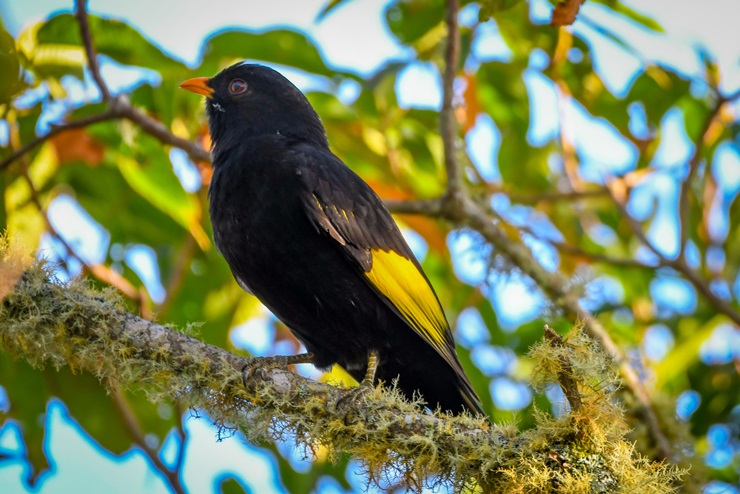
- Scientific name: Lipaugus ater
- Size: 24-27.5 cm (9.4-10.8 in)
Sexual dimorphism in black-and-gold cotingas is highly noticeable. While males are predominantly black, females have olive plumage. However, both have a bright yellow wing speculum on the secondary wing feathers. It’s unknown whether females have orange bills like males.
Black-and-gold cotingas are found only in Brazil. More precisely, they live in the Atlantic Forest in the Serra do Mar. They are not migratory, thus spending the breeding season (between September and December) in the same area.
These creatures feed almost exclusively on fruits and berries but may occasionally delight in an insect meal.
These birds are most renowned for their loud, piercing whistles, especially those heard from males!
8. Black Oystercatcher

- Scientific name: Haematopus bachmani
- Size: 47 cm (18.5 in)
- Weight: 0.9-1.3 kg (2-3 lb)
- Wingspan: 71-91.4 cm (28-36 in)
The black oystercatcher is probably the only species on our list with such a long bill! Besides this, it’s of a bright red-orange color, undoubtedly contrasting with the brownish-black plumage. The birds living in the north are known to be darker in color. The iris is bright yellow, while the eye ring is red. In short, this species should definitely get to your must-see list!
These unique birds are found on the shores of western North America. Some populations are migratory, while others remain within their range for the whole year. During the breeding season, they build small bowls or depressions as nests, typically close to the shore.
Once the females lay the eggs, male black oystercatchers become highly territorial and produce loud vocalizations while flying and foraging. Did you know that some black oystercatcher pairs were observed remaining together for many years?!
Black oystercatchers eat marine invertebrates, preferring mollusks, crabs, barnacles, and isopods.
9. South Island Oystercatcher

- Scientific name: Haematopus finschi
- Size: 46 cm (18.1 in)
- Weight: 550 g (19.4 oz)
- Wingspan: 80-86 cm (31.5-33.9 in)
The South Island oystercatcher has black-and-white plumage, the black feathers covering its head, neck, back, and wing. It has a remarkable bright red-orange bill, red legs, and a red eye ring. The bill is unusually long, serving for foraging and feeding.
As its common name suggests, the South Island oystercatcher can be found only in New Zealand. It breeds on the South Island, typically in braided river systems, cultivated lands, and subalpine tundra.
After the breeding season, they move to the North Island, where they reside in coastal estuaries, beaches, and intertidal mudflats.
Considering their preferred habitats, it’s only natural for South Island oystercatchers to feed primarily on mollusks, especially on Austrovenus stutchburyi, commonly called the New Zealand cockle. It occasionally feeds on worms as well.
